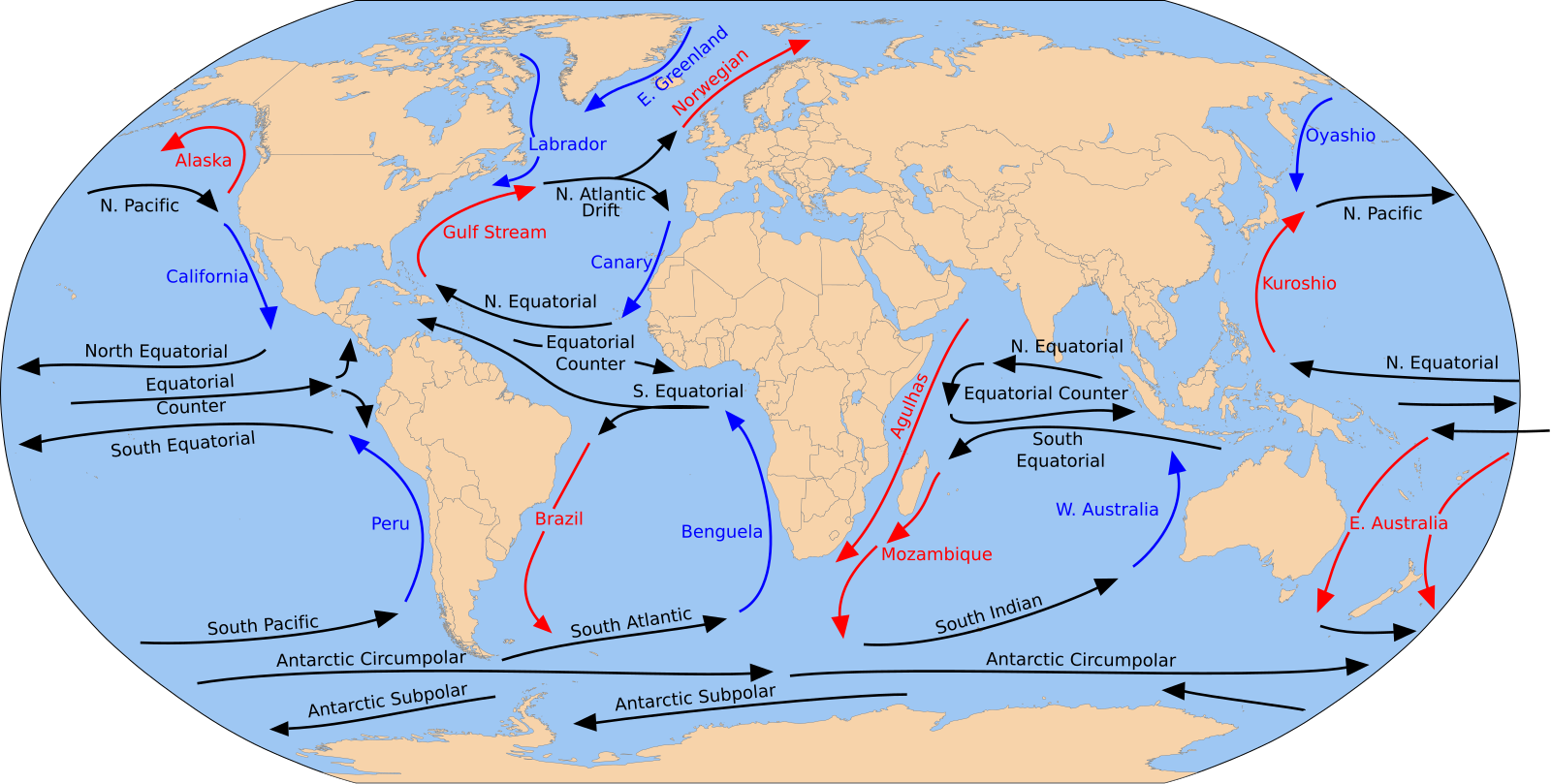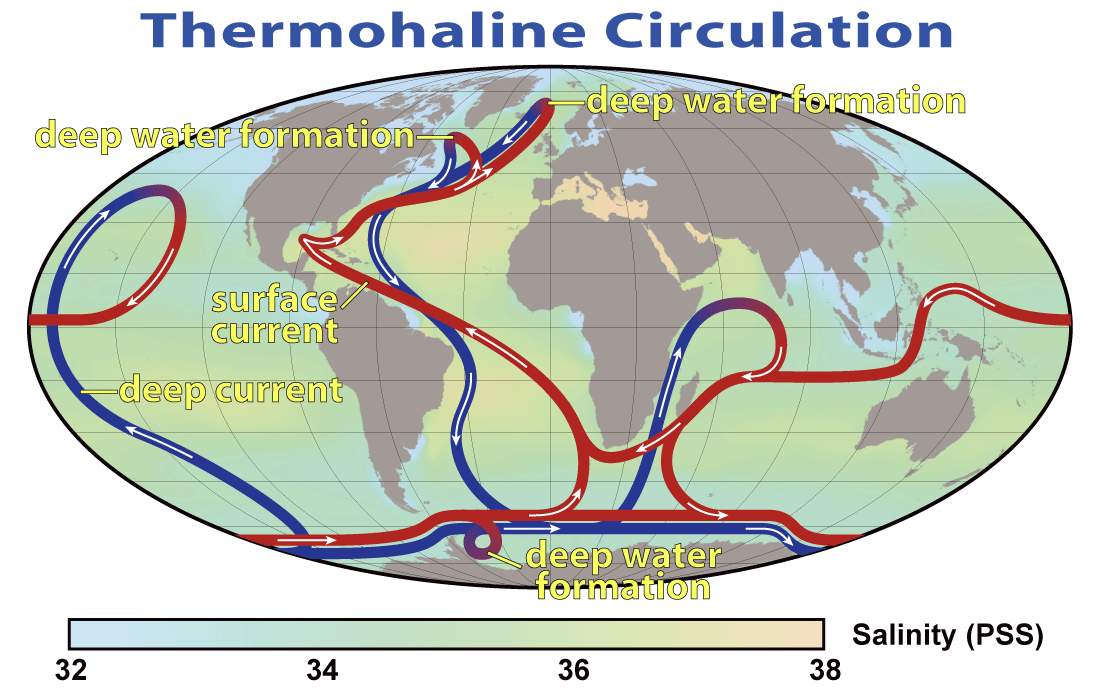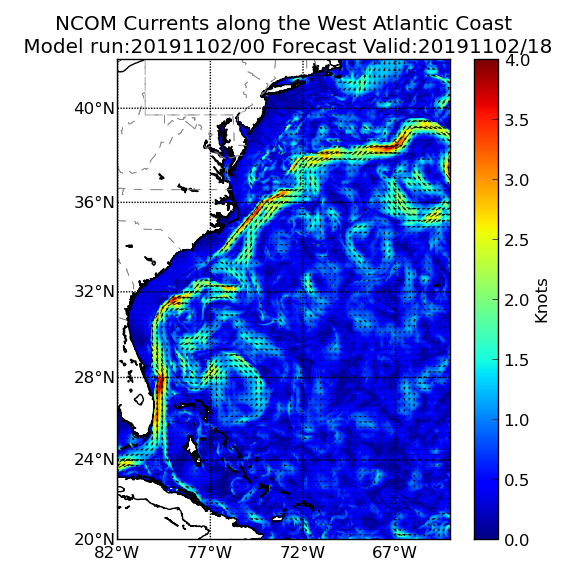IB Syllabus focus:
‘Oceans absorb solar energy; currents move heat globally, influencing regional climates and biome distribution.’
Oceans act as vast regulators of Earth’s climate. By absorbing, storing, and redistributing heat, they influence regional weather, global circulation, and the distribution of ecosystems and biomes.
Heat Absorption by Oceans
Solar Energy and Ocean Surfaces
The oceans absorb large amounts of solar radiation, particularly in tropical regions where sunlight is most direct. This absorbed heat warms the surface water, which is then redistributed by winds and ocean currents.

Warm (red) and cold (blue) surface currents move heat from the tropics toward higher latitudes and return cooler waters equator-ward, moderating regional climates and influencing nearby biome patterns. Major currents are labelled for orientation; cartography is simplified to emphasise heat redistribution. Source.
Heat Capacity of Water
Heat Capacity: The amount of energy required to raise the temperature of a substance by 1°C. Water has a high heat capacity, allowing it to store and release heat slowly.
Because of this property, oceans buffer temperature fluctuations, moderating both coastal and global climates.
Ocean Currents as Heat Conveyors
Surface Currents
Surface currents are primarily driven by wind systems and Earth’s rotation (the Coriolis effect). These currents transport warm water from equatorial regions toward the poles and return cooler water back toward the tropics.
Examples include:
Gulf Stream: Transfers warm water from the Caribbean towards north-western Europe, moderating the climate of countries such as the UK.
Kuroshio Current: Carries warm water northwards along East Asia.
Deep Ocean Circulation
Beneath surface currents lies the thermohaline circulation.
Thermohaline Circulation: The global conveyor belt of deep-water movement driven by differences in temperature (thermo) and salinity (haline), influencing density.
This system redistributes heat globally over thousands of years, linking surface and deep waters in a continuous cycle.

Schematic of global thermohaline circulation (“ocean conveyor”), showing warm, relatively shallow pathways and cold, deep return flows that connect basins and move heat on millennial timescales. Arrows indicate flow direction and relative depth; the diagram is conceptual rather than to scale. Source.
Mechanisms of Heat Redistribution
Convection and Mixing
Warm water expands, becomes less dense, and flows poleward.
Cold, dense water sinks at polar regions, creating convection currents.
This mixing ensures that heat is not confined to one region, but spread across ocean basins.
Heat Transfer Processes
Conduction: Heat passes directly between water molecules.
Convection: Heat moves with water masses during circulation.
Latent Heat Exchange: Heat absorbed or released during evaporation and condensation of water vapour contributes to atmospheric circulation.
Influence on Regional Climates
Coastal Climates
Regions near oceans experience moderated temperatures, with cooler summers and milder winters than inland areas at the same latitude.
Example: The west coast of Europe is warmer than equivalent latitudes in Canada due to the Gulf Stream.

Model output showing the Gulf Stream’s path and relative speed as it carries warm water poleward along the U.S. East Coast toward the North Atlantic, a key mechanism for regional heat transfer. The vector field includes operational detail (speeds and direction) beyond the ESS SL syllabus but clarifies the current’s structure. Source.
Monsoon Systems
Ocean heating drives monsoons. For example, in South Asia, differential heating between land and ocean directs moist winds inland, leading to heavy rainfall.
Polar Regions
The transport of warm water to high latitudes prevents extreme cooling, affecting ice cover and the albedo effect.
Impact on Biome Distribution
Temperature and Precipitation Patterns
Biome distribution is strongly influenced by ocean-driven climate regulation:
Tropical rainforests thrive near equatorial zones due to consistent heat and rainfall from oceanic heat release.
Deserts often form on western continental margins influenced by cold ocean currents, such as the Atacama Desert adjacent to the Humboldt Current.
Biodiversity and Productivity
Warm currents support high productivity in some regions by transporting nutrients, while cold upwelling currents fuel plankton blooms, providing the base of marine food webs.
Ocean–Atmosphere Interactions
El Niño and La Niña
These periodic changes in Pacific Ocean circulation disrupt global heat redistribution:
El Niño: Warm water spreads eastward, weakening upwelling and altering rainfall globally.
La Niña: Strengthens trade winds, enhances upwelling, and cools global temperatures slightly.
Hurricanes and Tropical Storms
Warm oceans provide the energy source for tropical cyclones. More absorbed heat intensifies storm strength and increases their potential impacts on coastal biomes.
Human Influence and Climate Change
Ocean Warming
Increased greenhouse gas emissions cause oceans to absorb excess heat, leading to:
Thermal expansion and sea level rise.
Disruption of thermohaline circulation.
Coral bleaching due to elevated sea surface temperatures.
Biome Shifts
As oceans redistribute heat differently under climate change, biomes shift poleward and species migration patterns alter, affecting both terrestrial and marine ecosystems.
Key Points for IB Students
Oceans act as global heat regulators due to high heat capacity.
Surface currents (wind-driven) and deep circulation (density-driven) redistribute heat.
Regional climates and biome distribution are directly shaped by these processes.
Human-induced climate change disrupts heat patterns, with consequences for ecosystems and biodiversity.
FAQ
The Coriolis effect, caused by Earth’s rotation, deflects moving water to the right in the Northern Hemisphere and to the left in the Southern Hemisphere.
This deflection shapes the direction of major currents, creating gyres that transfer heat across ocean basins. Without the Coriolis effect, currents would flow directly north–south and redistribute heat less effectively.
Western boundary currents, like the Gulf Stream, are narrow, deep, and fast-moving, carrying large volumes of warm water poleward.
Eastern boundary currents, such as the Canary Current, are broader, shallower, and slower, transporting less heat. Their main role is often in promoting upwelling rather than redistributing significant amounts of heat.
Currents redistribute heat by moving:
Warm water from low latitudes to high latitudes.
Cold water from polar regions toward the tropics.
This exchange prevents extreme heating at the equator and cooling at the poles, maintaining Earth’s overall energy balance.
Cold currents cool the air above them, reducing its ability to hold moisture.
As the air moves over land, there is little rainfall, creating deserts along western continental coasts. Examples include the Atacama Desert (Humboldt Current) and the Namib Desert (Benguela Current).
A slowdown could reduce the transport of warm water northwards, leading to colder conditions in Europe.
It could also disrupt rainfall patterns in the tropics, destabilise monsoon systems, and cause heat build-up in equatorial oceans, affecting global climate stability.
Practice Questions
Question 1 (2 marks)
Explain how ocean currents redistribute heat across the planet.
Mark scheme
1 mark for recognising that warm water is moved from equatorial regions toward higher latitudes.
1 mark for recognising that cooler water is returned from polar regions to the tropics.
Question 2 (5 marks)
Discuss how the redistribution of heat by oceans influences regional climates and the distribution of biomes.
Mark scheme
Up to 2 marks for describing how ocean currents moderate coastal climates (e.g., Gulf Stream warming north-western Europe, cold currents cooling west coasts).
Up to 2 marks for linking ocean-driven climate patterns to biome distribution (e.g., deserts near cold currents, tropical rainforests supported by warm currents and rainfall).
1 mark for providing a clear example that integrates both climate and biome distribution (e.g., Atacama Desert and Humboldt Current, or tropical rainforest productivity linked to warm ocean currents).

